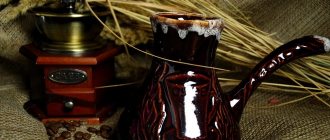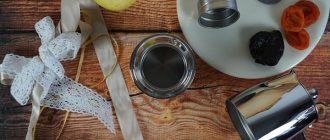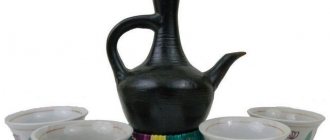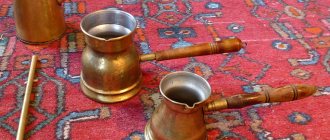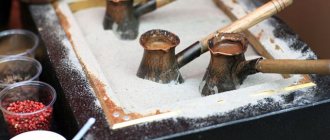The Right Ingredients
Quality coffee
Arabica and Robusta are the most popular varieties of coffee.
Precisely varieties, since these coffee trees are also divided into subspecies, so two different packages with the attractive inscription “100 percent Arabica” will have different tastes. Arabica has a more noble taste with a slight sourness, Robusta is coarser, astringent and strong. Robusta is never used in its pure form, only as an admixture to Arabica. It produces excellent dense crema in espresso, which is why baristas love it.
The taste of coffee depends on many factors: place of growth, degree of roasting, combination of varieties (if it is a mixture), storage conditions.
Proper coffee is sold in opaque packaging with a degassing valve, which removes carbon dioxide outside and prevents oxygen from penetrating inside. After roasting, coffee releases several liters of carbon dioxide during the day. If you see a package in a store without such a valve, it means that the coffee was not packaged immediately after roasting, but was left to degas for some time and has significantly lost its taste. Essential oils partially evaporate during degassing.
Look at the roast date. The closer it is to today's date, the better. Ideally, no later than two weeks, but this is difficult to achieve even for stores specializing in selling only coffee and tea.
Take coffee beans. There are several reasons for this.
- Self-ground coffee eliminates the presence of foreign impurities in the cup. It is easier for unscrupulous producers to mix cheaper varieties of robusta and even chicory, malt, barley, and rye into ground coffee. It’s better to grind it yourself, even in the simplest coffee grinder.
- The basis of the taste of coffee is essential oils. As we now know, oxygen is the main enemy of proper taste. Grinding before immediate brewing will maximize the aroma of the beans.
- You have more opportunities to experiment. Coffee for espresso machines requires a medium grind, for a French press - coarse, and for Turkish coffee it should resemble flour.
- You will be able to evaluate the shape of the grain itself, make sure that the grains are the same size, matte and intact. The uniformity of the grains eliminates the admixture of cheaper robusta. The shine indicates that the grain has been stale and has already begun to release essential oils. The splinters will produce a bitter taste as they are roasted more intensely than the whole grain. Of course, you can understand all this only when you open the package and draw conclusions about the manufacturer for the future.
Water
Ideally, spring water, but you can get by with filtered water. The main thing is not to take water directly from the tap and do not use already boiled water.
Spices
Some coffee lovers add a little salt when preparing, which helps to better reveal the taste and aroma of coffee and reduce bitterness. If you decide to use salt, then use the most common table salt, coarsely ground. There is a risk of over-salting with the extra variety, and iodized salt will give an unpleasant aftertaste.
From theory we move on to practice - brewing coffee.
Rules for storing grains
Beans should be stored in a sealed, opaque bag with a valve. Most manufacturers produce grains in this packaging. Protected from sunlight, moisture, oxygen and foreign odors, coffee will remain fresh for 1-2 months after roasting.
If you couldn’t use up a month’s supply of grains, you can put them in the freezer. Frozen grains are even easier to grind. It is important to remember that you cannot re-freeze them, like other products - they will lose taste, aroma and the internal structure will change.
Making coffee in Turkish
Choosing a Turk
Turka has been known since the times of the Ottoman Empire, and, in fact, the name of this dish speaks of its origin. In its historical homeland it is called cezve, and both names have taken root in the Russian language.
Today, Turks make from a variety of materials: copper, aluminum, stainless steel, brass and even ceramics. There are both small Turks for a 100 ml cup, and large ones for a solid mug.
Among coffee lovers, preference is given to copper small Turks.
Copper heats up evenly, and the small volume allows you to maximize the flavor of the grain.
Aluminum cookware heats up quickly, but in principle it is not advisable to use it for cooking any food, since this material reacts with food when heated. The stainless steel heats up unevenly, which is why a hot spot of the highest temperature appears in the center of the cookware, and the coffee begins to boil, although the temperature at the edges has not yet reached the desired level.
Ceramics and clay also warm up, but these materials continue to give off heat even when you have already removed the dishes from the stove: the foam will continue to rise, and there is a risk that you will flood the table or stove. Due to the porous structure, clay cezves absorb odors well, so over time the taste of coffee will only get better, but you can only use it for preparing one type.
If you have an induction cooker, then it makes no sense to take a ceramic pot: it simply won’t heat up. If you buy a copper one, please note that there should be special inserts in its bottom, onto which induction will be induced.
The most correct form of a Turk is a traditional conical one with a funnel-shaped bell. The cone will prevent the thickness from rising to the top, and the bell will prevent the foam from rising too quickly, which is especially important for those who have not had any experience using this cookware before. The handle can be any length, but the longer it is, the more convenient it will be for you to remove the Turk from the heat.
1 / 0
Correct Turk / maxidom.ru
2 / 0
The ladle, which the manufacturers mistakenly called a Turk / maxidom.ru
Cooking in Turk
Rinse the Turk, add 1 teaspoon of finely ground coffee and add 75 ml of cold water. Add sugar or a few grains of salt before putting the Turk on low heat. These components somewhat slow down the boiling process and make the foam denser.
Place on the fire, heat, but do not bring to a boil. Your main task now is not to be distracted and wait for the moment when the foam rises. Remember the funnel-shaped bell? It will increase your chances of capturing this moment and not letting the coffee flood the stove.
Remove the Turk from the heat, let the foam settle and put it back on the fire. Three times the foam should rise and three times you should lower it. The process is clearly shown in this video.
Using a Turk is not an easy task and requires attention and certain skills. But this particular method of brewing coffee has many followers, since it requires a minimum of equipment: only the right dishes and a stove.
How to clean a used pan from burnt food and coffee
Prompt cleaning is most effective. A metal sponge or abrasives are not suitable for cleaning the bottom and walls of dishes with a layer of enamel from burnt coffee. They form cracks and scratches on the enamel surface. It is better to use the following substances:
- Washing gel for household utensils: pour a drop of gel into boiling water and heat over a fire, or pour the gel into a pan and set aside, then clean with a sponge and rinse with tap water.
- Aerosol "Titan": spray onto surfaces with burnt food, then rinse with water.
- Salt: add salt to the soot, pour in water, let it brew for a couple of hours and boil for half an hour on the stove.
- Peel apples: clean the bottom of the dish or soak for 30 minutes while filling with water.
- Mixture: citric acid (half a pack), vinegar in the form of essence (30 grams) and soda (30 grams). Apply the mixture and clean off after half an hour.
It should be noted that all advice on how to brew coffee in a saucepan is conditional and relative. It is important to use quality ingredients. After mastering the technological process, experiments with aroma and intensity are not prohibited.
Post Views: 179
Making coffee in a geyser coffee maker
Choosing a coffee maker
The first geyser coffee makers appeared back in the 1930s. By the way, the company that designed them still exists today - the Italian Bialetti. Today, coffee makers of this type are produced by different companies.
When purchasing, you should focus on the material from which the coffee maker is made. You definitely shouldn't take aluminum specimens. But stainless steel or ceramics is a matter of taste.
Pay attention to the number of cups the coffee maker makes at a time.
In the case of a geyser coffee maker, you won’t be able to pour less water and add a spoonful of coffee in order to make one cup for yourself instead of six. You should always prepare the full amount. Moreover, different manufacturers may interpret the volume of one cup differently. For some it is 40 ml, for others it is 100. Find out this point before purchasing.
Cooking in a geyser coffee maker
Choose medium grind coffee and pour it into the filter. If you later find that there are coffee particles floating in your cup, it means that the grind was not coarse enough. Pour water into the bottom of the coffee maker.
As soon as the water boils, remove from heat. In this case, there is no need to be afraid of boiling, since the coffee itself will not heat up to 100 °C. Water under the pressure of the steam generated during boiling will pass through the filter with coffee and settle in the upper part of the coffee maker. With an electric device it is even simpler: as soon as the coffee is ready, it will turn off itself.
The entire process is shown in detail in the video instructions below.
If water leaks from the sides during use, it means that you have not tightened the parts tightly or have exceeded the maximum water mark.
Secret
If you don't have brown sugar in the house, try adding honey instead of white sugar. Please note that it is sweeter than sugar, you need to stir it when the coffee warms up a little. By the way, you also need to stir if you added refined sugar and not sand.
Do not pour out the coffee completely - let the grounds remain at the bottom of the pot.
Rinse the Turk immediately and without detergents; at most, wipe it with a sponge.
Always pronounce the word coffee in the masculine gender, otherwise he will be offended and not brew it.
Making coffee in an AeroPress
Choosing an Aeropress
The AeroPress is one of the newest ways to brew coffee. The device was invented in 2005 by Aerobie and has become so popular that since 2008, annual championships have been held for brewing coffee using the AeroPress.
There are no difficulties with choosing an AeroPress: the device is quite simple, the product configuration may change slightly from year to year, the manufacturer adds additional stirring spoons, replaceable filters, and funnels. The reason coffee brewing competitions are possible is because of the intricacies of using this simple device.
Cooking in an AeroPress
Grind 1.5 tablespoons of coffee and pour into the flask. The grind should be a little coarser than for Turks. You need to prepare 200 ml of hot water - not boiling water, the temperature should be about 90 °C. If you have a kettle with a thermostat, you can select the exact temperature. If not, wait three minutes after the kettle has boiled.
Fill the coffee with water. And from this moment the magic begins. The taste and strength of the drink depends on how long you keep the coffee in the flask and when you start stirring. It is no coincidence that a special application was released for iOS, telling how long coffee should be kept in an AeroPress.
AeroPress Timer
Beloved Robot, LLC
Price: 449.00 rubles
Download
Price: 449.00 rubles
Owners of Android smartphones are a little less fortunate: they will only be able to use a universal application that covers different methods of making coffee. There are also tips for Aeropress owners.
appbox fallback https://play.google.com/store/apps/details?id=com.hashbang.coffeepro&hl=ru&gl=ru
After the coffee has been standing for one to three minutes, put the filter on the flask, turn the Aeropress over and slowly push the coffee through the filter into the cup. If the piston moves hard, next time use a slightly coarser grind of coffee. The cooking process is shown in detail in this video.
The AeroPress is very easy to use, compact, easy to clean, coffee brews very quickly, and fine adjustments open up a truly limitless field for experimenting with the taste of your favorite drink. The only drawback is that there will be no coffee foam with this brewing method, since the water is heated separately from the beans.
Advice
One of the main attributes of Armenian coffee is foam. To achieve this, take a Turk, as written above, and stir the coffee once, when the ingredients are collected together and water is poured. Then we just wait.
When the coffee is brewed, spoon the foam into a cup to preserve it and then carefully pour the drink into it.

